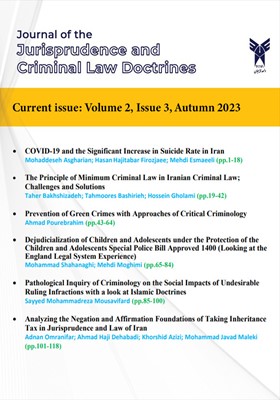COVID-19 and the Significant Increase in Suicide Rate in Iran
Subject Areas : Jurisprudence and Criminal Law Doctrines
Mohaddeseh Asgharian
1
,
hasan hajitabar firozjaee
2
*
![]() ,
Mehdi Esmaeeli
3
,
Mehdi Esmaeeli
3
1 - Ph.D. student in criminal law and criminology, Ayatollah Amoly Branch, Islamic Azad University, Amoly, Iran
2 - Associate Professor, Department of Law, Faculty of Humanities, Islamic Azad University Qaimshahr Branch, Qaimshahr, Iran
3 - Assistant Professor, Department of Law, Central Tehran Branch, Islamic Azad University, Tehran, Iran.
Keywords: suicide factors, suicide and covid-19, suicide and post-covid-19,
Abstract :
Receive Date: 2023/06/25 Revise Date: 2023/08/29 Accept Date: 2023/09/10AbstractThe main aim of this research is the recognition of effective causes and factors in increase of suicide and offering approaches in prevention of suicide in period of coivd-19 and post covid-19 in Iran. In this research, the cases of dead people were surveyed in Alborz province in 1400 and information related to suicides was extracted from the forensic medicine files. Researches then contacted with the families to survey the causes of suicide and complete questionnaires to collect the required information. Data was analyzed using descriptive analysis statistics to determine the frequency of causes, risk factors and suicide methods. This results showed that 180 cases out of 260 successful suicides were male and 80 cases were female. The most common suicide age was the third decade of life and most statistics of suicides were among individuals with elementary education. In 38 percent of cases, the cause of suicide was unknown; but where the cause was identified, the most common cause was mental disorders. Overall, hanging with 45.5 percent was the most common method of suicide. The most common method among male was hanging and among female was poison consumption that there was significant relationship between method of suicide and gender. Self-immolation was in high rate in both gender and involved 35 percent of female. The covid-19 pandemic has been significantly associated with increasing suicide rates in Iran, especially between young men and people with lower education. Emphasizes on providing psychological and economic protective programs focused on societies at-risk is necessary in confronting with this worried increase.
_||_

